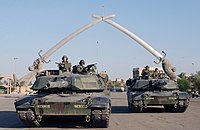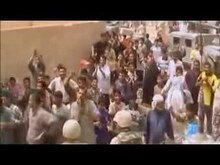Battle for Baghdad (2003)
| date | 4. bis 9. April 2003 |
|---|---|
| place | Baghdad , ( Iraq ) |
| output | United States victory |
| consequences | The fall of Baghdad ends the Saddam regime |
| Parties to the conflict | |
|---|---|
| Commander | |
|
Tommy Franks (Commander U.S. Central Command ), |
|
| Troop strength | |
| 45,000 | 30,000 |
| losses | |
|
2,320 dead, number of wounded unknown |
34 dead, several 100 wounded |
The Battle of Baghdad was a military operation as part of the Iraq War . The battle for the Iraqi capital Baghdad began on April 3, 2003 with the attack on the international airport in the south of the city. After just a few days, the fighting ended on April 9 with the fall of Baghdad and the fall of Saddam Hussein's regime . On May 1, US President George W. Bush announced the end of the main fighting on the aircraft carrier USS Abraham Lincoln . The occupation of Iraq , which lasted until 2011, began with the end of the battle .
Battle for the international airport
In the early morning hours of April 3, 2003, the decisive battle for Baghdad began with an intensive bombardment of Saddam International Airport . The uninterrupted bombing of the capital and the airport began at midnight. In large parts of the city, there were massive power outages for the first time since the fighting began . In the southwest the 3rd US Infantry Division had advanced within ten kilometers of the city limits. The attack on the airport was preceded by heavy artillery fire on the Iraqi positions in the southern part of Baghdad and on the airport premises. On the night of April 4, the 1st Brigade of the 3rd US Infantry Division advanced with 4600 soldiers and 120 M1 Abrams main battle tanks onto the airfield. Already on the morning of April 4 was Brigadier General Vincent K. Brooks , deputy director for operations of the US Central Command in Doha ( Qatar ) announced that the airport had been taken as far as possible and was American US control.
Beginning of the decisive battle
During the attack on the international airport on April 3, preparations began for the invasion of Baghdad. The US High Command deployed special troops to operate on the outskirts. These scouting parties reported information about the enemy units and their whereabouts. The air forces used the information to coordinate the air strikes and to define targets. The high command hoped for a further advantage from this tactic: "The Iraqi armed forces should be confused by these operations and their resistance weakened, so that a house-to-door war with many losses does not occur."
April 4, 2003 began with a bombardment. The targets of the air strike were the positions of the Republican Guard and the airport's fuel depot. After the successful capture of Saddam International Airport, the 101st Airborne Division began to move part of its troops from Najaf to Baghdad. The US 1st Marine Division controlled the access roads in the southeast of the capital. During the day, the units of the encountered Marines ago to the northeast. The resistance of the Iraqi troops turned out to be low. Special forces units cordoned off Baghdad in the north and the 2nd Brigade of the 3rd US Infantry Division occupied the southern highways. In the late evening hours of April 4, 2003, US troops controlled all access roads to Baghdad. The goal of encircling Baghdad before marching into the city center was achieved.
The Republican Guard barracks in southwest Baghdad were attacked by the 2nd Brigade on April 5th. The Iraqi troops offered stronger resistance, but could not successfully defend their base against the American superiority.
Course of the fight in the center
On April 5, US troops advanced into the city center for the first time. As a vanguard, a battalion (Task Force 1-64 Armor) of the 2nd Brigade of the 3rd US Infantry Division drove its armored vehicles from the south into the city. The action lasted around three hours and was intended to determine the resistance and fighting strength of the Iraqis. An estimated 1,000 Iraqis were killed and 100 vehicles destroyed in the operation. The American troops lost one soldier and one M1 Abrams main battle tank. As a result of the successful course, the US military gained the hoped-for information about the strength of the resistance and was convinced that it could break it. Statements from captured Iraqis suggested that they believed the Iraqi propaganda that the Americans were being stopped well outside the gates of Baghdad. Since the advance had only touched the western outskirts of Baghdad, foreign media reported on April 5 that the US troops were not in Baghdad itself. With this knowledge, the American generals came to the conclusion that a media presence of the US troops in Baghdad was necessary to expose the statements of the Iraqi government as false and to overthrow the regime.
On Sunday, April 6, US Lockheed C-130 transport aircraft landed for the first time at Baghdad International Airport, which has now served as a base for the Americans. On the same day, Saddam Hussein issued the order to remove all street signs in the city so that the US troops could lose their orientation. Due to a lack of personnel and a lack of time, the order could not be implemented. Many civilians left the urban area and fled from the upcoming fighting.
Soldiers from the 1st Marine Division advanced across the Diyala River to the southeast of the city on April 7 . The Iraqis tried to stop the advance with their T-72 tanks . The marines were instructed to call for air support immediately in the event of strong enemy contact so that their own losses would be as low as possible. So the Iraqi tanks were destroyed by fighter planes. The US Air Force flew 500 attacks that day, most of which came about through requests from ground troops.

The 2nd Brigade of the 3rd US Infantry Division was given the task of taking the presidential palaces and other public facilities and symbols of Saddam Hussein's power in the western city center, and keeping them overnight if possible. The units of the 2nd Brigade had 70 Abrams and 60 Bradley tanks available for this order. Air support for the ground forces was provided by Fairchild-Republic A-10 ground attack aircraft. The attack was coordinated by the Tactical Operations Center (TOC) at the motorway junction south of the city; the 2nd Brigade also used the area as a base and started its mission from there. The way to the palace and administrative district of Baghdad led over several highway bridges. There the units of the 2nd Brigade met with the strongest resistance. Coordination of the Iraqi resistance no longer took place at this point. The army's chains of command no longer existed and many Iraqi soldiers fled because of American superiority. The fedayeen offered heavy resistance to the invaders, but their actions were also uncoordinated. After the 2nd Brigade had already conquered the New Presidential Palace, the 1st was to take another palace, the Fau Palace. About 300 Iraqis died that day as a result of the fighting by the 3rd Infantry Division.
The Tactical Operations Center was the target of a missile attack on the afternoon of April 7th. The Iraqis shot at the camp with a cruise missile . Five people were killed in this shelling.
Since the conquest of the palaces, the soldiers remained in the city and were no longer withdrawn to the airport. April 8th began with the bombing of the Ministry of Information, the Republican Guard headquarters and the Ba'ath Party building . The occupation of the four most important bridges over the Tigris in central Baghdad should be achieved on that day. The tanks of the 3rd US Infantry Division moved out at 4 a.m. and encountered the fiercest resistance since the war began. The Iraqis had prepared for the invasion and built ramparts and roadblocks. Iraqi snipers posed a certain threat that the tank crews ignored and resulted in casualties. In the late afternoon, US tanks fired at the Al Jazeera office. A cameraman from the news broadcaster was killed in a tank shell. On the evening of April 8, all four Tigris bridges in the center were under the control of the US military.
On the same day, the 1st US Marine Division was able to capture and secure the Raschid military airfield . The airport had been held by Republican Guard units for days .
Early in the morning of April 9, the 2nd Brigade of the 3rd Infantry Division occupied and occupied important positions, including the Oil Department, Baghdad Main Street, the Secret Police headquarters and the city's university. At 6:00 pm, a US soldier covered the Saddam statue in front of the Palestine Hotel on Firdaus Square, first with the US flag and later with an Iraqi flag; the image of it symbolizes the end of the Iraq war . The statue was then brought down with the help of an M88 armored recovery vehicle.
Shelling of the Hotel Palestine
The Palestine Hotel on the banks of the Tigris in central Baghdad has been used by the international press as its headquarters and media center since the beginning of the war. Even the high command of the US Armed Forces knew of the presence of the press in the said hotel. On April 8, an M1 Abrams main battle tank fired a shell at the hotel, which hit the 15th floor. Two journalists were killed in the shelling . Three other journalists suffered minor and major injuries in the incident.
On April 27, 2007, three members of the US 3rd Infantry Division were charged in a Spanish court with bombarding the hotel and killing a Spanish journalist.
Baghdad after the battle
The house-to-house war for the Iraqi capital, initially feared, did not take place. On April 9, the center of Baghdad was under the control of the US armed forces. US Army officials later announced a reason for the low resistance: some officers had been bribed in advance of the fighting.
Simultaneously with the end of the fighting, there were looting in some places, which particularly affected hospitals and the National Museum. Other facilities such as the Home Office and the Ministry of Oil, however, were secured in good time by American troops. As in other parts of the country, there was chaos in Baghdad for days.
Troops
Notes and sources
- ↑ Stefan Aust, Cordt Schnibben: Iraq - History of a Modern War , 2004, page 351.
- ↑ Stefan Aust, Cordt Schnibben: Iraq - History of a Modern War , 2004, page 377.
- ↑ Stefan Aust, Cordt Schnibben: Iraq - History of a Modern War , 2004, page 386.
- ↑ Herald Tribune: Spanish judge indicts 3 US soldiers in connection with journalist's death , April 27, 2007.
- ^ Chaos in Baghdad: Medical care before the collapse. In: Spiegel Online . April 10, 2003, accessed January 6, 2017 .
- ^ A b Hans Wagner: Looted art from Mesopotamia: stolen to order? In: eurasischesmagazin.de. April 4, 2003, accessed January 6, 2017 .
- ↑ Iraq: Now the law of the jungle applies. In: Spiegel Online . April 11, 2003, accessed January 6, 2017 .
literature
- Stefan Aust, Cordt Schnibben : Iraq. Story of a modern war. Dtv, 2004.
Web links
- US Forces Enter the Heart of Baghdad (English)
- US Forces Occupy Palaces (English)
- CNN-Iraq War Special (English)
- Evening paper



